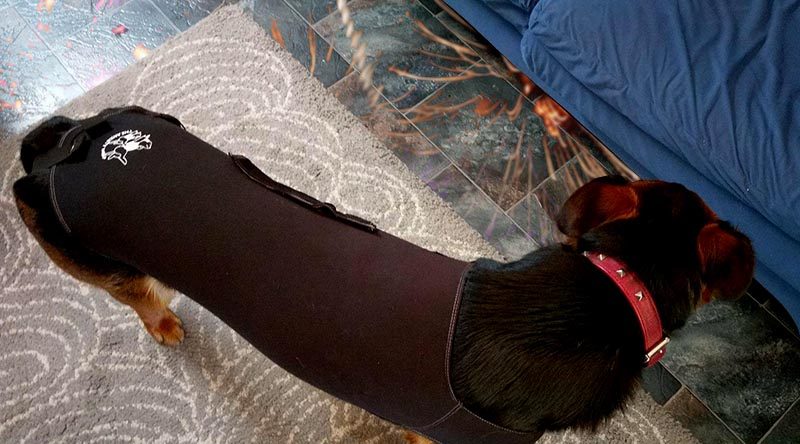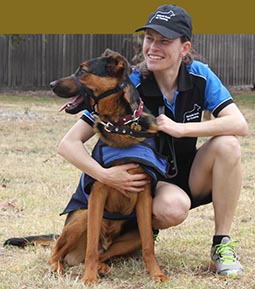Thunderstorms, fireworks and fear

As the end of the year approaches, two things are certain – increased thunderstorm activity and Christmas/New Years’ firework displays.
Dogs have incredible hearing ability. Anything that sounds loud to us is amplified significantly for dogs. They can hear sounds we can’t.
Loud noises such as fireworks or thunderstorms can cause a dog to panic – and dogs in a panicked state can do things they wouldn’t normally do. Many try to run away from the noise. Dogs that have never tried to escape their yard find themselves desperately climbing the fence and running the streets. Dogs have been found several suburbs away from their homes.
Other dogs may try to enter the house, damaging door frames, or hiding under furniture.
Panicking dogs are also more vulnerable to injury – car accidents while running the streets, torn nails and paw pads climbing fences or becoming trapped under cupboards and furniture.
Fortunately, there are several ways you can minimise distress levels in your dog on these occasions.
Preparing for a potential situations
It’s always better to be safe than sorry. Microchipping is crucial, if, in the worst-case scenario, your dog escapes. It is essential you keep your contact details updated. If you can’t be located, your dog can’t be returned.
Bring your dog inside the house to prevent the opportunity for escape.
Creating background noise can help take the highs and lows out of a thunderstorm or fireworks display. Putting on a load of washing, running the clothes drier, turning on the radio or TV can all provide some background noise.
What happens if you’re not home when the storm is predicted? Ensure your dog is in a safe place in the house, for example, laundry or bathroom.
Some dogs respond well to noise desensitisation therapy. In simple terms, that’s playing a sound that would normally be scary to your dog for a prolonged period at such low volume that it does not cause distress to the dog. CDs or iTunes downloads of thunder and fireworks can be played at very low volume throughout the day to become background noise for your dog. Start with the volume so low your dog is barely aware of the sound, he may flick his ears occasionally or tilt his head in response to it but he should not be frightened by it. It needs to be a minor background noise. Over time, you can slowly increase the volume, remembering you don’t want to evoke a fear response. Depending on your dog, this may be days or weeks.
Other dogs seem unfazed by the ‘fake’ storm noises but remain distressed when a storm hits. Why is that? Well, as thunderstorms approach, changes occur in atmospheric pressure and dogs can sense this.
So, while w\e may not be able to replicate atmospheric changes, we can work on noise sensitivity.
What is a fear response?
A few common early responses to fear include lip licking, cowering, tail between legs, ears pressed flat back against the head – progressing to hiding from the sound, trying to pull away from the stressor (object/sound causing the stress) and shaking.
If your dog becomes fearful, avoid the urge to comfort him as this can make his fear worse rather than better. Petting a stressed dog tells him “it’s ok you have a good reason to be scared”.
After the preparation is complete and the stressful event has started, give your dog minimal attention, behave as though it is just another day, nothing different is happening.
Alternative management techniques
If you are concerned about your dog’s fear, talk to your vet.
This is particularly important before trying herbal remedies or treatments found on the internet.
Please, please, do not give your dog human medication to try and calm him down. This is not only dangerous, but it could even be lethal for your dog.
There are many products on the market claimed to alleviate stress. Some dogs respond well to stress-relieving pheromone sprays. Brands include Adaptil. Similar products can be applied via collar or oral drops.
These types of products need to be applied before the stressful event (fireworks) begin.
Calming jackets, anxiety wraps or thunder shirts can assist some dogs experiencing mild anxiety. These items work by exerting pressure around the dog, kind of like a hug. I would only advise using these garments if the dog is supervised, otherwise the fabric may catch on an object and the dog could become entangled.
The key to using these garments is to get your dog used to wearing the jacket when he isn’t stressed. You need to build a calm association with the jacket. If you only apply it when there is a storm or fireworks display the dog can associate wearing the jacket to mean bad things are going to happen – the exact opposite of what you are trying to achieve.
If you are concerned your dog is exibiting fear during fireworks or thunderstorms, you can reach out for assistance to a qualified dog trainer, behaviourist or your vet.
Wishing you and your pets a happy, health, safe and stress free New Year. See you back here in 2018.
.
,
Melanie Scott is a former police officer with PTSD. She is a qualified dog trainer who is passionate about dogs and helping first responders. Melanie Scott K9 Training (MSK9T) offers a variety of services including group dog-obedience classes, puppy classes, private in-home consults, as well as therapy and service-dog training. You can contact Melanie on 0448 395 797 or visit her web site.
.
.
.
.
.
.
.

.
.

.






![[Then] Minister for Veterans and Defence Personnel Darren Chester in front of a recently delivered Pilatus PC-21 at RAAF Base East Sale. Photo by Corporal Dan Pinhorn.](https://www.contactairlandandsea.com/wp-content/uploads/2020/02/chester_pc21-390x205.jpg)